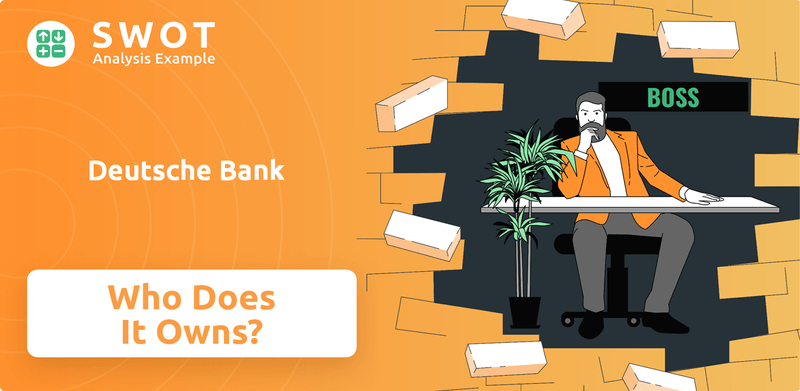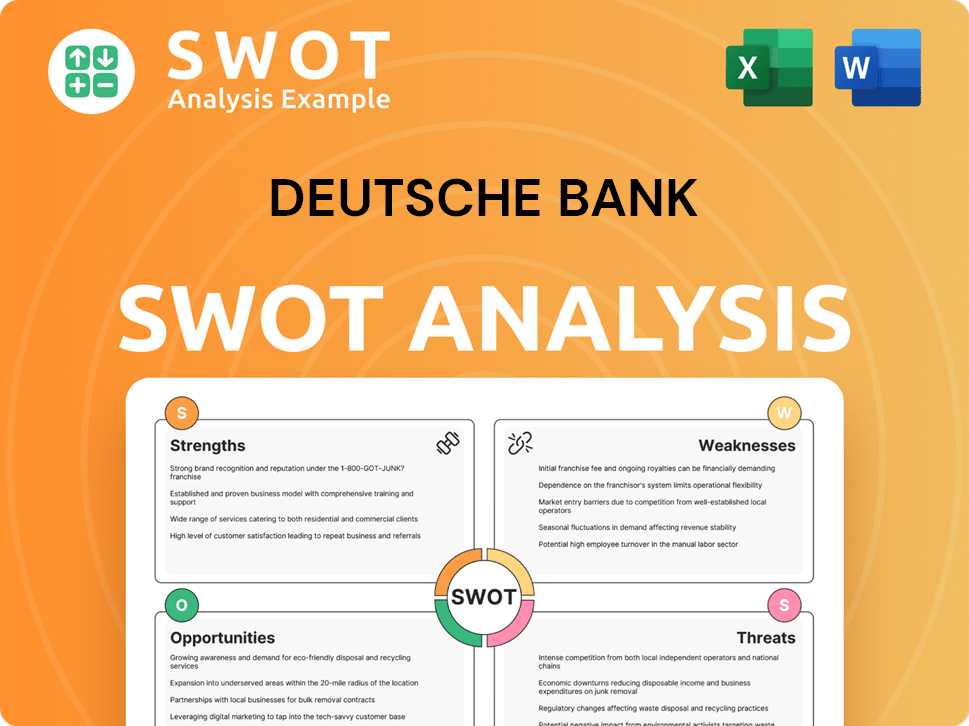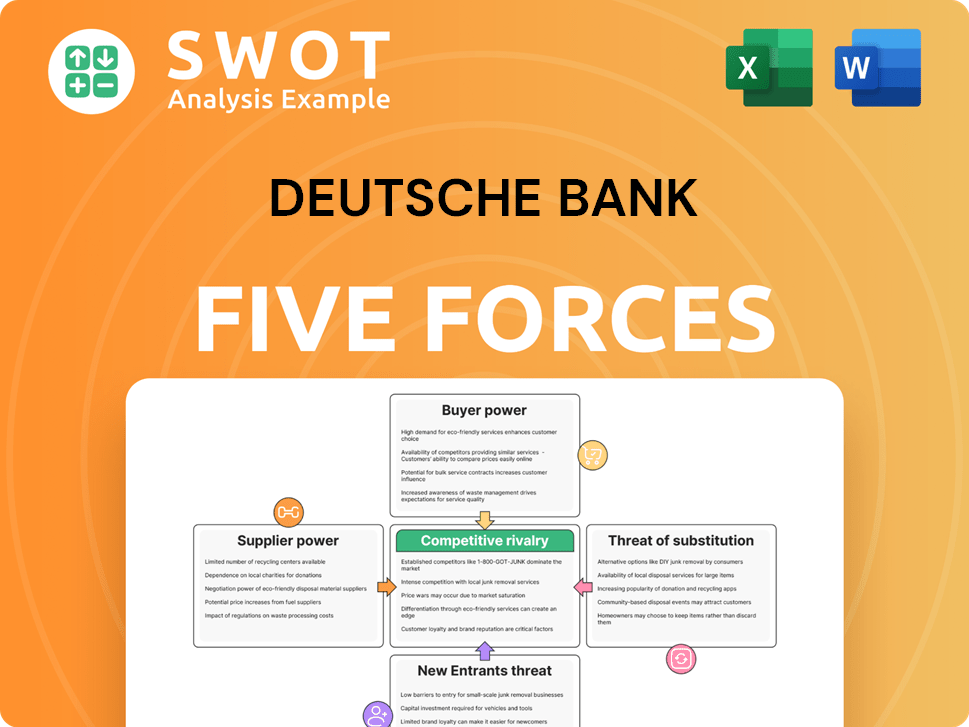Deutsche Bank Bundle
Who Truly Controls Deutsche Bank?
Unraveling the Deutsche Bank SWOT Analysis is crucial for anyone looking to understand its strategic positioning. The ownership structure of Deutsche Bank, a global financial powerhouse, is a dynamic landscape shaped by institutional investors, individual shareholders, and historical influences. Understanding who owns Deutsche Bank is key to grasping its future direction and performance. This analysis delves into the intricacies of Deutsche Bank's ownership.

From its founding in 1870 to its current status, Deutsche Bank's ownership has evolved significantly, reflecting its growth and adaptation to global market dynamics. Examining the Deutsche Bank ownership and the influence of its major Deutsche Bank shareholders provides valuable insights into the bank's governance and strategic decisions. This exploration of Who owns Deutsche Bank will cover Deutsche Bank stock ownership, Deutsche Bank history, and the impact of key Deutsche Bank executives.
Who Founded Deutsche Bank?
Deutsche Bank's origins trace back to March 10, 1870. The bank was founded by Ludwig Bamberger, Adelbert Delbrück, and L. A. Jordan. The initial capital amounted to 15 million thalers, setting the stage for a significant financial institution.
Ludwig Bamberger, a key figure, was a prominent economist and politician. He championed the creation of a strong financial entity to support German foreign trade. Adelbert Delbrück, a banker and entrepreneur, brought his financial expertise to the founding team. The bank's structure was designed to foster international trade finance.
The bank was established as a joint-stock company. This meant ownership was distributed among shareholders through the purchase of shares. Early support came from a group of private bankers and industrialists. This reflected a widespread desire to build a robust financial infrastructure for Germany's growing economy.
While specific equity splits at the beginning aren't readily available in public records, the bank's structure as a joint-stock company indicates distributed ownership. The early shareholders included a consortium of private bankers and industrialists. This setup was crucial for supporting Germany's expanding economy and its focus on international trade.
- The founders' vision was to create a bank with a global orientation, focusing on international trade finance.
- The initial capital of 15 million thalers was a significant amount at the time, highlighting the ambition of the project.
- The involvement of private bankers and industrialists shows the broad-based support for the bank.
- The bank's structure as a joint-stock company allowed for diverse ownership from the start.
For more insights into the bank's strategic direction, you can explore the Target Market of Deutsche Bank.
Deutsche Bank SWOT Analysis
- Complete SWOT Breakdown
- Fully Customizable
- Editable in Excel & Word
- Professional Formatting
- Investor-Ready Format

How Has Deutsche Bank’s Ownership Changed Over Time?
The ownership structure of Deutsche Bank has seen considerable evolution since its initial public offering. As a publicly traded entity, listed on the Frankfurt Stock Exchange under the ticker DBK and with American Depositary Receipts (ADRs) trading on the New York Stock Exchange under the ticker DB, its ownership is largely dispersed. This distribution involves a mix of institutional investors, mutual funds, index funds, and individual shareholders. The dynamics of this ownership have been shaped by various market conditions, regulatory changes, and strategic decisions made by the bank itself.
Key events impacting Deutsche Bank's ownership include periods of financial restructuring, mergers and acquisitions, and shifts in investor sentiment. For example, during times of financial instability, the bank has had to manage investor confidence, which can lead to changes in shareholding patterns. Furthermore, regulatory changes, such as those related to capital requirements and stress tests, can influence investor perception and, consequently, ownership dynamics. The bank's strategic decisions, including its focus on certain business areas or geographic regions, also play a role in attracting and retaining specific types of investors.
| Shareholder | Approximate Percentage (Late 2024) | Notes |
|---|---|---|
| BlackRock, Inc. | Approximately 4.98% | One of the largest asset managers globally. |
| The Vanguard Group | Around 3.01% | Another significant institutional investor. |
| Norges Bank Investment Management | Data not available for 2025 | A major sovereign wealth fund. |
The major shareholders of Deutsche Bank, including institutional investors like BlackRock and Vanguard, wield significant influence through their voting rights. While these entities typically do not engage in day-to-day management, their decisions on shareholder resolutions and proxy votes can indirectly affect the company's strategy and direction. Changes in major shareholding, such as large block trades or shifts in institutional investment strategies, often reflect market sentiment and can impact the bank's stock performance. For more insights into the bank's strategic approach, consider exploring the Marketing Strategy of Deutsche Bank.
Deutsche Bank's ownership is primarily held by institutional investors, with BlackRock and Vanguard being prominent shareholders.
- Ownership structure is dispersed, reflecting its status as a publicly traded company.
- Major shareholders influence the bank through voting rights and shareholder resolutions.
- Changes in shareholding can impact market sentiment and company strategy.
- Understanding the ownership structure is crucial for assessing the bank's stability and direction.
Deutsche Bank PESTLE Analysis
- Covers All 6 PESTLE Categories
- No Research Needed – Save Hours of Work
- Built by Experts, Trusted by Consultants
- Instant Download, Ready to Use
- 100% Editable, Fully Customizable

Who Sits on Deutsche Bank’s Board?
Deutsche Bank operates under a two-tier board system, which is standard in Germany. This structure includes a Management Board (Vorstand) and a Supervisory Board (Aufsichtsrat). The Management Board handles the daily operations, while the Supervisory Board oversees the Management Board, representing both shareholders and employees. As of early 2025, the Supervisory Board's composition reflects this dual representation, as mandated by German co-determination laws. The board includes members with expertise in areas such as international finance, law, and corporate governance, ensuring a diverse range of perspectives.
The Supervisory Board includes representatives from shareholders and employees. Shareholder representatives often have extensive financial backgrounds and may be linked to major institutional investors. Independent directors also play a crucial role in providing oversight and ensuring adherence to corporate governance best practices. This structure helps to balance the interests of various stakeholders, contributing to the bank's strategic direction and operational oversight. Understanding the Revenue Streams & Business Model of Deutsche Bank is also crucial to understanding the bank's overall strategy.
| Board Level | Responsibilities | Composition |
|---|---|---|
| Management Board (Vorstand) | Day-to-day operations, strategic execution | Executive directors |
| Supervisory Board (Aufsichtsrat) | Oversight, shareholder and employee representation | Shareholder and employee representatives, independent directors |
| Key Functions | Monitoring, strategic guidance, appointment of Management Board | Ensuring compliance and representing stakeholder interests |
The voting structure at Deutsche Bank generally follows a one-share-one-vote principle for common shares. There are no known dual-class shares or special voting rights that would give disproportionate control to specific individuals or entities. Recent years have seen activist investor campaigns focused on profitability and restructuring, influencing strategic discussions, but these have not led to significant proxy battles that fundamentally altered the board's composition. These campaigns highlight the ongoing scrutiny from Deutsche Bank shareholders and the importance of shareholder value in the bank's decision-making processes.
Deutsche Bank's governance structure is based on a two-tier board system, common in Germany. The Supervisory Board oversees the Management Board. The board includes shareholder and employee representatives.
- Two-tier board system
- Shareholder and employee representation
- One-share-one-vote principle
- Activist investor influence
Deutsche Bank Business Model Canvas
- Complete 9-Block Business Model Canvas
- Effortlessly Communicate Your Business Strategy
- Investor-Ready BMC Format
- 100% Editable and Customizable
- Clear and Structured Layout

What Recent Changes Have Shaped Deutsche Bank’s Ownership Landscape?
Over the past few years, specifically from 2022 to 2025, the ownership landscape of Deutsche Bank has seen subtle shifts. The bank's ownership remains largely dispersed, with no single entity holding a controlling stake. However, share buyback programs, such as those announced in 2024, have incrementally increased the ownership percentages of existing shareholders. These actions are part of Deutsche Bank's capital management strategy, aimed at returning value to shareholders. The Growth Strategy of Deutsche Bank includes initiatives that indirectly influence investor confidence and, by extension, shareholder behavior.
Institutional investors continue to play a significant role in Deutsche Bank's shareholder base, reflecting broader industry trends. The bank's focus on improving profitability and efficiency is a key factor in attracting and retaining these investors. While there haven't been major alterations in the ownership structure due to significant new strategic investors or secondary offerings, the bank's commitment to shareholder value remains a central theme in its public communications. This commitment often involves discussions about capital returns, which are designed to maintain a stable ownership base and boost shareholder confidence.
| Shareholder Type | Approximate Percentage | Notes (as of early 2024) |
|---|---|---|
| Institutional Investors | ~50-60% | Includes asset managers, investment funds, and other financial institutions. |
| Retail Investors | ~30-40% | Comprises individual shareholders. |
| Other (including treasury shares) | ~5-10% | Includes shares held by the company itself and other minor shareholders. |
The composition of Deutsche Bank's shareholder base shows a significant presence of institutional investors, typically holding around 50-60% of the shares. Retail investors account for approximately 30-40%, while the remaining shares are held by other entities, including the company's treasury shares. These figures highlight the diversified nature of the bank's ownership, with no single shareholder wielding dominant control. Share buybacks and the ongoing focus on profitability are key strategies that influence the ownership dynamics and investor confidence.
Share buybacks have been a consistent feature, returning capital to shareholders and slightly increasing the ownership percentage of existing investors.
The bank is actively working to improve profitability and operational efficiency to attract and retain institutional investors.
The ownership structure remains largely dispersed, with no single controlling shareholder, providing stability.
Leadership changes, such as the evolution of the Management Board, do not typically lead to direct shifts in ownership.
Deutsche Bank Porter's Five Forces Analysis
- Covers All 5 Competitive Forces in Detail
- Structured for Consultants, Students, and Founders
- 100% Editable in Microsoft Word & Excel
- Instant Digital Download – Use Immediately
- Compatible with Mac & PC – Fully Unlocked

Related Blogs
- What are Mission Vision & Core Values of Deutsche Bank Company?
- What is Competitive Landscape of Deutsche Bank Company?
- What is Growth Strategy and Future Prospects of Deutsche Bank Company?
- How Does Deutsche Bank Company Work?
- What is Sales and Marketing Strategy of Deutsche Bank Company?
- What is Brief History of Deutsche Bank Company?
- What is Customer Demographics and Target Market of Deutsche Bank Company?
Disclaimer
All information, articles, and product details provided on this website are for general informational and educational purposes only. We do not claim any ownership over, nor do we intend to infringe upon, any trademarks, copyrights, logos, brand names, or other intellectual property mentioned or depicted on this site. Such intellectual property remains the property of its respective owners, and any references here are made solely for identification or informational purposes, without implying any affiliation, endorsement, or partnership.
We make no representations or warranties, express or implied, regarding the accuracy, completeness, or suitability of any content or products presented. Nothing on this website should be construed as legal, tax, investment, financial, medical, or other professional advice. In addition, no part of this site—including articles or product references—constitutes a solicitation, recommendation, endorsement, advertisement, or offer to buy or sell any securities, franchises, or other financial instruments, particularly in jurisdictions where such activity would be unlawful.
All content is of a general nature and may not address the specific circumstances of any individual or entity. It is not a substitute for professional advice or services. Any actions you take based on the information provided here are strictly at your own risk. You accept full responsibility for any decisions or outcomes arising from your use of this website and agree to release us from any liability in connection with your use of, or reliance upon, the content or products found herein.